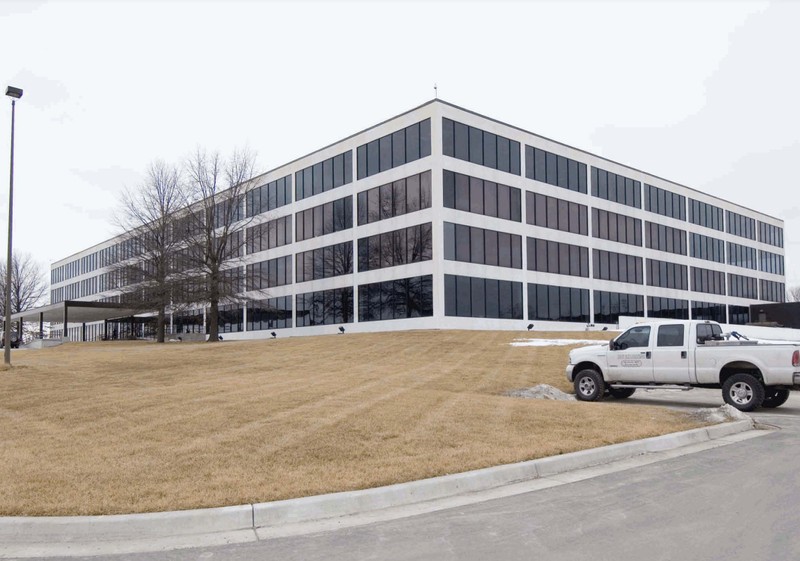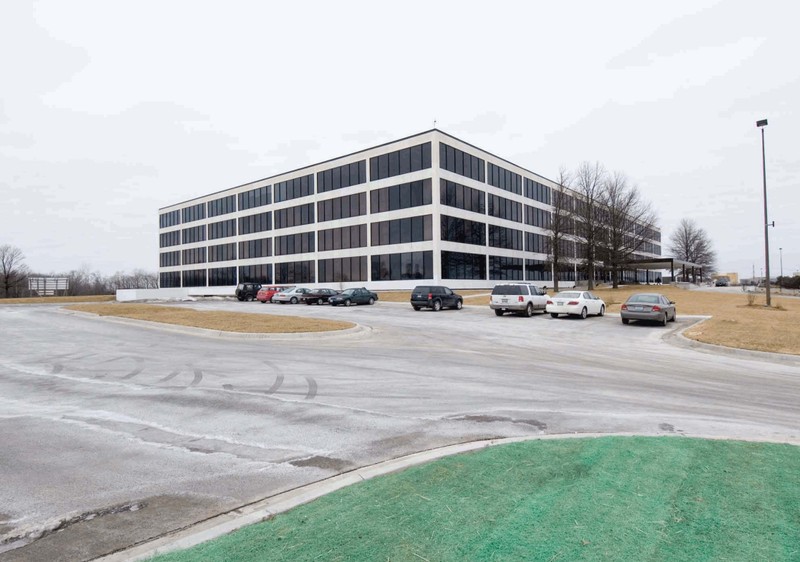TWA Administrative Offices Building
Introduction
Text-to-speech Audio
Trans World Airlines (TWA) established its home in Kansas City during the 1930s, and the airline built its now-historic TWA Administrative Offices Building from 1968 to 1972 to use as its corporate headquarters. TWA, a leader in international travel and an airline giant in the 1960s and 1970s, constructed the building with the impression that Kansas City and its International Airport would experience robust growth. More than 2,000 people worked in the historic TWA Administrative Offices Building at the company’s peak, a time when TWA was Kansas City's largest employer and contributed roughly $200 million annually to the local economy.
Images
TWA Administrative Offices Building, built in 1972

TWA Administrative Offices Building, built in 1972

Backstory and Context
Text-to-speech Audio
The genesis of TWA dates back to 1925 with the organization of Western Air Express, which transported U.S. Mail and occasional passenger service between Los Angeles and Salt Lake City. In 1929, the airline added daily flights between Los Angeles and Kansas City and then a link between Kansas City and the East Coast, which put Western Air Express in competition with Transcontinental Air Transport Company; the two companies merged in 1930 to become Transcontinental and Western Air.
One year later, in 1931, Kansas City voters approved funding for a public improvements program, including a bond issue for expanding the city's new Municipal Airport. Thus, Transcontinental and Western Air, which calculated that Kansas City stood twelve hours from any point in its flight network, selected Kansas City as the base of its maintenance, ground operations, and general offices.
Upon selecting Kansas City as a base, Transcontinental and Western Air transferred 250 workers and their families to the city. The airline forecast Kansas City to evolve into one of the nation's most significant air hubs. Indeed, the city had already spent decades as one of the nation's most integral railroad and trucking hubs. Kansas City also served as the midway point and an overnight stop in the airline's thirty-six-hour coast-to-coast daylight flight that started in 1934, substantially benefiting Kansas City's downtown hotel and restaurant businesses. In 1939, the airline made Kansas City its corporate home, in addition to serving as the base for its maintenance and ground operations.
By the 1940s, during World War II, TWA routinely worked with the U.S. military, further allowing the airline to develop its international presence. By 1945, the airline operated routes to Europe, the Middle East, and India; the company subsequently changed its name to Trans World Airlines. During the 1950s, TWA continued to expand its domestic and international routes, reaching profits of $10 million annually by 1954. TWA was the first airline to introduce an all-cargo service across the Atlantic Ocean. In 1959, TWA entered the jet age by flying passengers non-stop from San Francisco to New York via a Boeing 707, followed by a flight from Los Angeles across the North Pole to London.
Kansas City's economy reaped the benefits of TWA's success and growth. Kansas City's 687-acre Municipal Airport served up to one million passengers annually, serving TWA along with such airlines as Continental, Delta, and Ozark. As TWA grew, its office and maintenance space at the airport proved insufficient, pushing TWA to open additional offices in downtown Kansas City. In 1964, TWA established its national administrative headquarters in New York and transferred its senior executive staff from Kansas City to New York. Also, in the 1960s, TWA moved its flight hub from Kansas City to St. Louis. Still, TWA's employee numbers more than doubled from 1958 to 1968, and it stood as Kansas City's largest employer during the early 1960s. The company modernized and streamlined its ticketing, sales, and public services departments in the late 1960s, and the airline became the first to offer all-jet service on both domestic and international routes.
Also, by the late 1960s, Kansas City began developing and constructing Kansas City International Airport. TWA catered to more than twelve million passengers who flew fourteen billion passenger miles on TWA, and cargo volume rose thirty-three percent over the previous year. TWA's all-jet fleet numbered 170 aircraft. In addition to occupying thirty percent of the new airport's terminals, TWA's facility growth at the new airport included the expansion of its international overhaul and maintenance program, construction of giant hangers for recently purchased Boeing 747 and supersonic transport jet planes, and the central administrative building. Furthermore, TWA also started the process of building the now-historic office building near the new airport. By July 1968, TWA budgeted $90 million in new construction projects in Kansas City for completion in 1971, amounting to a community investment by TWA of more than $115 million. The now-historic TWA Administrative Offices opened in 1972, and four years later, the company reported a profit of $30 million; economists calculated that TWA contributed more than $200 million annually to the Kansas City economy.
Rising fuel costs and inflation during the late 1970s, followed by the deregulation of the airlines, took its toll on TWA and led to its decline. By the early 1990s, mounting debt, bad corporate deals, and another round of rising fuel costs and associated economic decline finally ended TWA's long run of dominance and led to two bankruptcy filings. However, TWA continued to lose money, leading to its sale in 2001; American Airlines purchased TWA. The building survives as a reminder of Kansas City's rise to an international airline hub, anchored by TWA and its immense success
Cite This Entry
Powers, Mathew and Clio Admin. "TWA Administrative Offices Building ." Clio: Your Guide to History. September 10, 2023. Accessed April 2, 2025. https://theclio.com/entry/167902
Sources
Beyman, Michael J. "TWA Airlines History." USA Today. March 23, 2017. http://traveltips.usatoday.com/twa-airlines-history-21998.html.
Loh, Chris. "The Rise & Fall Of TWA." Simple Flying. simpleflying.com. May 29, 2020. https://simpleflying.com/twa-history/.
"Plane Speaking." Kansas City Public Library. kchistory.org. Accessed May 6, 2023. https://kchistory.org/week-kansas-city-history/plane-speaking.
Schwenk, Sally and Kerry Davis "Registration Form: TWA Administrative Offices Building." National Register of Historic Places. mostateparks.com. 2007. https://mostateparks.com/sites/mostateparks/files/TWA%20Admin%20Offive%20Bldg.pdf.
"TWA History: Kansas City & TWA." TWA Museum. Accessed May 6, 2023. https://twamuseum.org/history.
NRHP: https://mostateparks.com/sites/mostateparks/files/TWA%20Admin%20Offive%20Bldg.pdf
NRHP: https://mostateparks.com/sites/mostateparks/files/TWA%20Admin%20Offive%20Bldg.pdf

